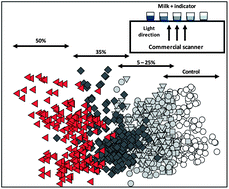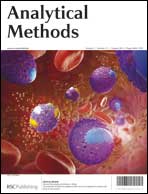This paper proposes the use of digital imaging as an alternative method for the identification and quantification of milk adulteration. Bovine milk samples were furnished by a local milk company (São Carlos, SP, Brazil) and spiked with tap water, whey, hydrogen peroxide, synthetic urine and synthetic milk at different levels of adulteration. Digital images were obtained by a flatbed scanner and the means of ten color descriptors (red, green, blue, hue, saturation, value, luminosity and the three relative colors, i.e. relative red, relative blue and relative green) were used to evaluate the information from the images. Classification models exhibited tight and well-separated clusters allowing the discrimination of control from adulterated milk samples. Regression models were developed by using partial least squares (PLS) and principal component regression (PCR) and results showed that the method could be applied to estimate adulteration levels in milk with high coefficients of correlation (r) and low standard error of prediction (SEP). This method can be potentially used as an alternative to the traditional methods due the simplicity, sensitivity, low cost and portability allowing in situ analysis.

You have access to this article
 Please wait while we load your content...
Something went wrong. Try again?
Please wait while we load your content...
Something went wrong. Try again?


 Please wait while we load your content...
Please wait while we load your content...